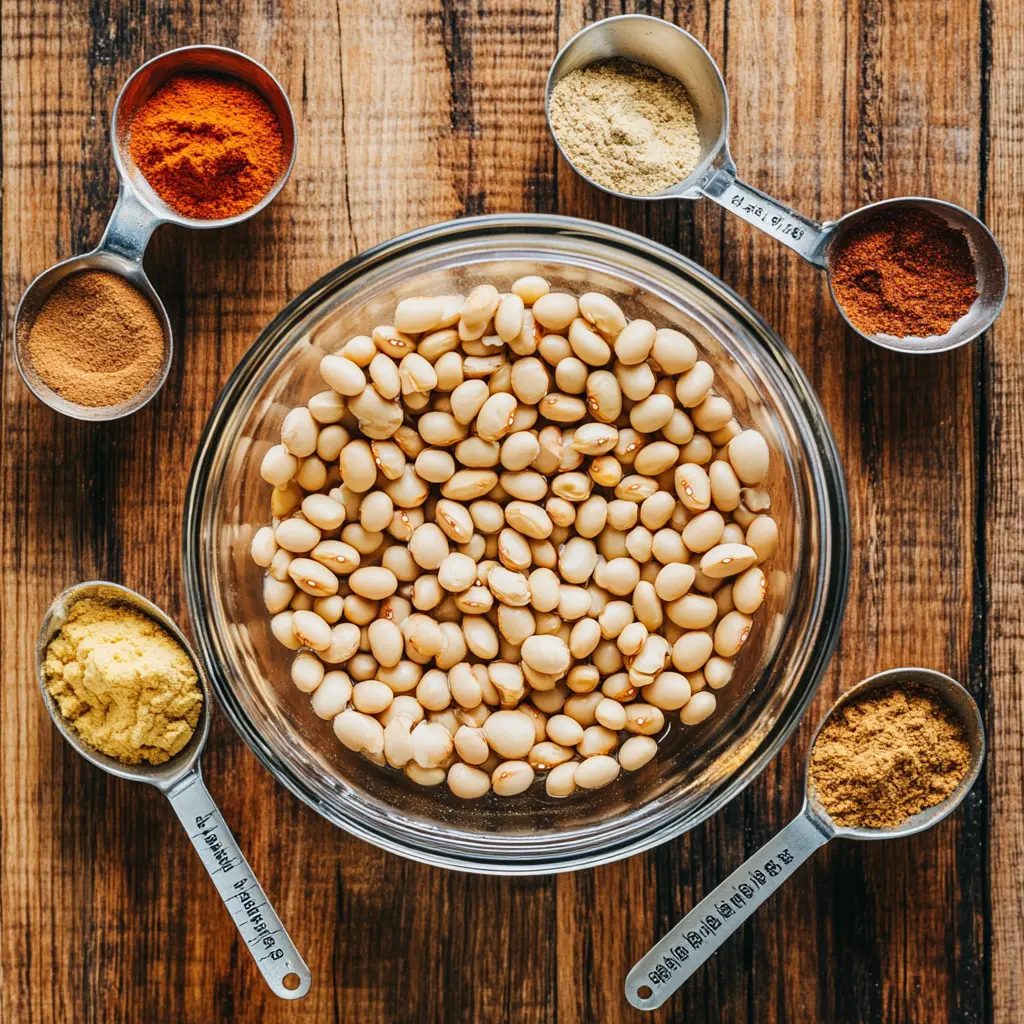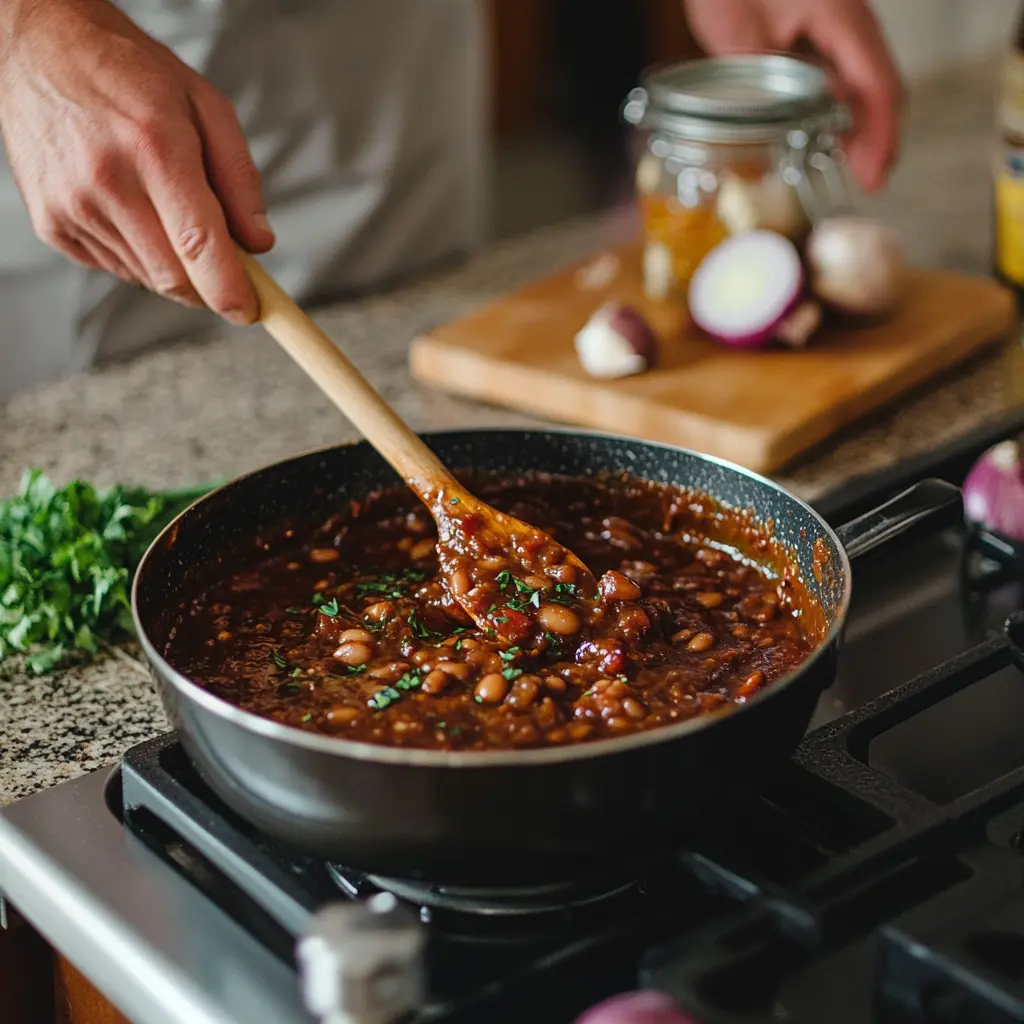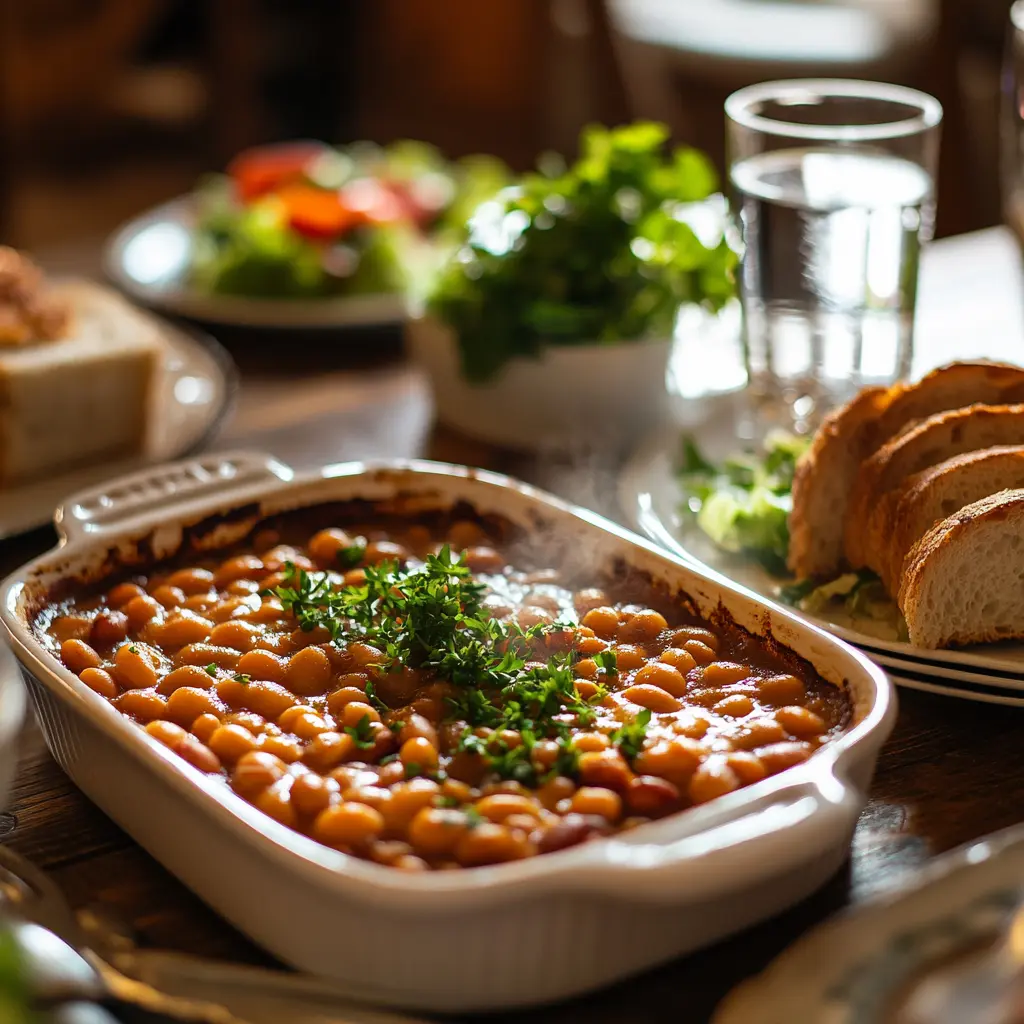Nothing says comfort food like a warm, hearty bowl of baked beans. Whether you’re hosting a family dinner, planning a barbecue, or just craving something rich and flavorful, a well-made baked beans recipe can be your ultimate go-to dish. This guide walks you through everything you need to know, from selecting the best ingredients to step-by-step cooking techniques, exciting variations, and tips for serving. Let’s dive in and uncover the secrets to creating the perfect baked beans!
PrintThe Ultimate Baked Beans Recipe: Easy, Delicious, and Nutritious
Ingredients
Part 1: Introduction to Baked Beans
History and Origin of Baked Beans
The humble baked bean has a fascinating backstory that spans continents and centuries. Traditionally rooted in Native American cooking, the dish evolved with the introduction of molasses and tomatoes during colonial times. Over the years, regional twists, like Boston baked beans or Southern-style baked beans, have added rich diversity to this timeless recipe. Today, this classic comfort food finds a spot on dinner tables and cookouts across the globe.
Nutritional Benefits of Baked Beans
Baked beans are not only delicious but also packed with essential nutrients. They’re an excellent source of plant-based protein, making them ideal for vegetarians. Rich in dietary fiber, they support healthy digestion and help maintain steady blood sugar levels. Additionally, baked beans offer essential vitamins like folate and minerals such as iron and magnesium. Who knew indulgence could be so healthy?
Why Learn the Perfect Baked Beans Recipe?
Mastering a homemade baked beans recipe empowers you to control the ingredients and flavors, avoiding excess sugar or preservatives found in store-bought options. Plus, it allows for creative variations to suit your dietary needs or taste preferences. The best part? It’s easier than you might think to create a dish that’s both healthy and full of flavor!
Part 2: Ingredients for the Ultimate Baked Beans Recipe
The foundation of any baked beans recipe lies in choosing the perfect beans. While navy beans are the traditional choice due to their creamy texture and ability to absorb flavors, you can experiment with others. Pinto beans bring a slightly nutty flavor, while kidney beans offer a robust bite. Choose dried beans for a more authentic texture or canned beans for convenience, but always rinse and sort them before use.
Sweeteners: Brown Sugar, Molasses, or Maple Syrup?
What makes baked beans irresistibly sweet and savory is the right choice of sweetener. Brown sugar is a classic option that caramelizes beautifully during cooking. Molasses adds a deep, smoky flavor and a touch of old-world charm. For a lighter sweetness with a natural twist, maple syrup is an excellent alternative. You can even combine them to create a balance that’s just right for your palate.
Enhancing Flavor with Add-ins: Onions, Peppers, and More
The magic of a homemade baked beans recipe lies in the supporting ingredients that build layers of flavor. Onions lend a subtle sweetness as they cook, while bell peppers add color and a mild tang. Garlic can elevate the dish with its bold aroma, and a dash of smoked paprika or mustard powder creates depth. Don’t forget a touch of tomato paste or puree for a rich, savory base that ties everything together.
Seasonings to Seal the Deal
Seasoning is the unsung hero of any traditional baked beans recipe. Salt and pepper are must-haves, but spices like cumin or coriander can add unexpected warmth. Want a hint of heat? A pinch of cayenne pepper or red chili flakes will do the trick. Fresh herbs, such as thyme or parsley, work wonderfully as a garnish to brighten the flavors.
With these ingredients, you’re ready to create a baked bean dish that tastes as good as it looks. Up next, we’ll explore the art of bringing these flavors together in the cooking process!
Part 3: Step-by-Step Cooking Instructions
Preparing the Beans: Soaking and Pre-Cooking
To achieve perfectly tender and flavorful baked beans, preparation is key. If you’re using dried beans, start by soaking them overnight in plenty of water. This step not only softens the beans but also reduces cooking time and improves digestibility. After soaking, drain and rinse the beans thoroughly, then simmer them in fresh water until they’re tender but not mushy. This ensures they hold their shape during baking.
For canned beans, a quick rinse under cold water is all you need to remove excess sodium and improve their texture.

Crafting the Perfect Sauce: Balancing Sweet and Savory
The heart of a great baked beans recipe lies in its sauce. In a medium-sized mixing bowl, combine tomato paste, brown sugar, molasses, and your chosen seasonings. Stir in a splash of vegetable stock or water to create a sauce that’s rich yet pourable. For added depth, mix in a dash of mustard powder and a sprinkle of smoked paprika.
Cook this sauce on low heat in a skillet until it thickens slightly, allowing the flavors to meld together. Taste and adjust the balance of sweetness and tanginess as needed—this step is where personal preference truly shines.
Baking Techniques: Oven vs. Slow Cooker Methods
Now comes the fun part—assembling and cooking your baked beans! Both the oven and slow cooker offer unique advantages depending on your schedule and desired texture.
- Oven Method: Preheat your oven to 325°F (165°C). In a baking dish, combine the pre-cooked beans and sauce, mixing gently to coat each bean evenly. Cover with foil or a lid to prevent drying out, and bake for 1.5 to 2 hours, stirring occasionally. Remove the cover during the last 30 minutes for a caramelized top layer.
- Slow Cooker Method: For a hands-off approach, transfer the beans and sauce into your slow cooker. Cook on low for 6-8 hours or high for 3-4 hours, stirring occasionally to ensure even cooking. The slow cooker method results in a creamier texture and intensified flavors.
Tips for Consistent Results
- Stir the beans gently to avoid breaking them during cooking.
- If the sauce thickens too much, add a small amount of water or vegetable stock to maintain a smooth consistency.
- Keep tasting throughout the process to adjust seasoning—it’s better to tweak early than after it’s done!
By following these steps, you’ll be rewarded with a batch of baked beans that are tender, flavorful, and downright irresistible. Next, we’ll explore exciting recipe variations to suit every palate!
Part 4: Variations of Baked Beans Recipes
Vegetarian and Vegan Alternatives
If you’re looking for a plant-based twist on the classic baked beans recipe, you’re in luck. Replace traditional meat-based add-ins with ingredients like smoked tofu or tempeh for a protein boost and a subtle smoky flavor. A dash of liquid smoke or smoked paprika can mimic the depth traditionally achieved with meats.
For the sauce, stick with plant-based staples: tomato puree, brown sugar, and molasses. If you want a creamy touch, coconut milk can work wonders without overpowering the other flavors. These vegan-friendly tweaks maintain all the deliciousness while keeping the dish inclusive.
Regional Twists: Boston, Southern, and International Styles
Baked beans have countless regional variations, each offering a unique flavor profile. Here’s a glimpse into a few:
- Boston Baked Beans: This iconic version uses molasses as its signature ingredient, resulting in a dark, rich, and slightly sweet sauce. A touch of dry mustard adds subtle heat.
- Southern-Style Baked Beans: Known for their bold flavors, Southern baked beans often incorporate tangy barbecue sauce, diced peppers, and a hint of sweetness from honey or syrup.
- International Variations: From the spicy tomato-based versions in Mexico to the curried baked beans of India, global interpretations add exciting dimensions to the dish. Feel free to adapt the recipe by experimenting with spices like cumin, coriander, or even turmeric.
Customizing Flavors to Suit Your Taste
The beauty of a homemade baked beans recipe lies in its adaptability. You can tweak the sweetness, adjust the spices, or introduce new ingredients to suit your personal preferences. For example, if you love a smoky flavor, increase the amount of smoked paprika or use fire-roasted tomatoes. For a milder dish, reduce the seasoning and let the natural sweetness of the beans shine.
A Recipe for Every Occasion
Whether you’re preparing for a family potluck or whipping up a quick weekday meal, there’s a baked beans variation that fits the bill. With endless possibilities for customization, this dish truly has something for everyone.
Up next, we’ll dive into serving suggestions and storage tips to make the most of your delicious creation!
Part 5: Serving Suggestions and Storage Tips
Ideal Occasions for Serving Baked Beans
Baked beans are a versatile dish that shines in various settings. They’re a quintessential side dish for summer barbecues, perfectly complementing grilled vegetables, burgers, or smoky tofu steaks. At family gatherings or potlucks, they steal the show with their rich flavors and comforting texture. Don’t overlook baked beans as a main course either—they’re hearty enough to star on a weeknight dinner table, paired with a fresh salad or crusty bread.
Complementary Dishes: What Goes Well with Baked Beans?
The sweet and savory profile of baked beans pairs beautifully with a range of dishes. Here are a few ideas to complete your meal:
- Cornbread: The slightly sweet, crumbly texture of cornbread balances the richness of baked beans perfectly.
- Roasted Vegetables: A medley of oven-roasted carrots, zucchini, and bell peppers adds color and freshness.
- Mashed Potatoes: Creamy and buttery mashed potatoes are an excellent companion for soaking up the flavorful sauce.
- Grilled Entrées: Whether it’s veggie kebabs, seared tofu, or a grilled plant-based protein, baked beans are a great match.

Proper Refrigeration and Freezing Methods
Baked beans are a meal prep hero! They store exceptionally well, allowing you to enjoy leftovers without compromising on flavor.
- Refrigeration: Transfer cooled baked beans into an airtight container and store them in the fridge for up to 5 days. To maintain their texture, keep them in the sauce rather than separating the beans.
- Freezing: For longer storage, freeze baked beans in a freezer-safe container. Leave a bit of space at the top to account for expansion. They’ll stay fresh for up to 3 months. When you’re ready to enjoy them, thaw in the fridge overnight.
Reheating Without Losing Flavor and Texture
Reheating baked beans is straightforward, but a little care ensures they taste just as good as when freshly made.
- Stovetop Method: Heat the beans on low in a saucepan, stirring occasionally to prevent sticking. Add a splash of water or vegetable stock if the sauce thickens too much.
- Microwave Method: Place the beans in a microwave-safe dish, cover loosely, and heat in short intervals, stirring in between to distribute the heat evenly.
By storing and reheating baked beans properly, you can savor their deliciousness long after they’re cooked. Up next, we’ll wrap things up with a helpful FAQ section addressing common questions about baked beans recipes!
Part 6: Frequently Asked Questions (FAQs)
Can I use canned beans instead of dried beans?
Absolutely! Using canned beans is a great time-saver. Just rinse them thoroughly to remove excess sodium and ensure a cleaner flavor. While canned beans may lack the depth of texture you get from dried beans, they work perfectly for quick and easy baked beans recipes.
How can I make baked beans less sweet?
To reduce sweetness, adjust the amount of brown sugar, molasses, or other sweeteners in the recipe. You can balance the flavors by adding a splash of vinegar, more tomato paste, or a pinch of smoked paprika. Taste as you go to ensure you get the perfect balance of tangy and savory.
What are some meat-free alternatives to bacon in baked beans?
For a vegetarian or vegan twist, consider smoked tofu, tempeh, or even roasted mushrooms to replicate the smoky, savory flavors traditionally provided by bacon. A sprinkle of smoked paprika or a few drops of liquid smoke can also do wonders.
How long can I store baked beans in the refrigerator?
When stored in an airtight container, baked beans can last up to 5 days in the refrigerator. Keeping them submerged in their sauce helps maintain moisture and flavor.
Can baked beans be frozen for later use?
Yes! Baked beans freeze beautifully. Cool them completely before transferring them to a freezer-safe container, leaving some space for expansion. They’ll keep well for up to 3 months. Just thaw overnight in the fridge and reheat as needed.
What dishes pair well with baked beans?
Baked beans are incredibly versatile and pair well with dishes like cornbread, roasted vegetables, mashed potatoes, or grilled entrees. They also complement salads and steamed greens for a lighter option.
With these answers, you’re now equipped to troubleshoot common issues and make the most of your baked beans recipe. Next, we’ll wrap up this comprehensive guide with a brief conclusion!
Conclusion
Baked beans are a timeless dish that brings warmth, flavor, and versatility to any table. Whether you’re crafting a classic recipe or exploring creative variations, the beauty of baked beans recipes lies in their adaptability. From the choice of beans and sweeteners to cooking methods and regional twists, every step allows you to customize and perfect your dish.
With proper storage and reheating techniques, baked beans can easily fit into your meal prep routine, offering a nutritious and satisfying option whenever you need it. By following this guide, you’re well on your way to mastering a recipe that’s not only delicious but also steeped in history and tradition.
Now it’s your turn to get cooking—because nothing beats the aroma of a homemade batch of baked beans! Happy cooking!

